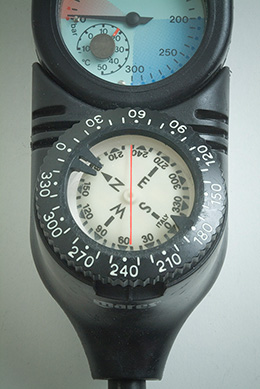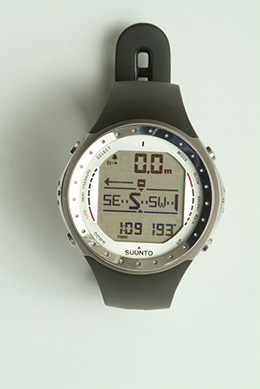Finding Your Way Aided by a CompassContents of this Issue: Top Dive, French Polynesia: Part I Touch Me Not! Leave the Dolphins Alone My Word, Itís Ugly Down There! Goodbye American Pioneer Diver Out-of-Practice, but I Want to Dive French Polynesia Dominica, Fiji, Belize, Costa Rica, Florida Advanced Danish POV Camera Finally Available Two Cameras to Start your Underwater Photographer Career Those Internet-Based Dive Travel Websites Harassing Animals and Coral to Attract Business Use the 24-Hour Rule to Your Advantage Donít Wash a Wound with Sea Water The Only Time You Should Hold Your Breath The Florida Shark Diving Saga Continues Finding Your Way Aided by a Compass A Bad Weekend At a Training Lake What Do You Have in Your Dive Bag? Editorial Office: Ben Davison Publisher and Editor Undercurrent 3020 Bridgeway, Suite 102 Sausalito, CA 94965 an item of equipment thatís often overlooked from the July, 2017 issue of Undercurrent
Divers who frequent dive sites with lousy visibility would shake their heads at those who enjoy good visibility and rarely have a use for a compass, so don't know how to use one. If you can see where you're going, what's difficult about keeping the reef on your right during the way out and on your left when you return? But, if you dive in low visibility, featureless sandy plateaus, or a wreck you are not moored over, you need a compass, and you need to know how to use it. If you do know how, read no further.
But pity the poor diver who leaves his dive boat in Truk Lagoon, only to miss the wreck and spend his dive swimming over acres of seabed. It happens!
The card or needle wants to point to magnetic north. To use a compass correctly, you need to hold it so the fixed arrow marked along the side of the compass points in the direction you wish to travel. This arrow is called the 'lubber line.' Ensuring that the compass card or needle can swing freely, rotate the moveable bezel so that its position is marked. Adjust your direction as you swim so that the needle remains in this position. When you want to return on a reciprocal course, you simply rotate the bezel through 180į and swim back. Some compasses have a sight glass that allows you to take a bearing, and you merely need to add or subtract 180į for the reciprocal course.
Many computers now offer an electronic compass mode. Take a bearing of where you want to head, and, keeping the electronic compass level, follow the bearing. Some will automatically give you the reciprocal bearing, but none, however high tech they might be, can take currents into consideration. Unless you are heading exactly and directly into a current, it is inevitable that you will be pushed off course. You will need to vector a course, which is nigh on impossible. Never forget that Christopher Columbus traveled west, but hit the Bahamas rather than what was to become Manhattan. That's why it's important to navigate short distances between specific and noticeable points of interest in the undersea terrain. Slavishly following the compass will lead to mistakes, whereas this point-to-point piloting as you go adds gentle corrections. Magnetic compasses are cheap to buy and low tech. Before you enter the water, either from the shore or a boat, get someone to point out roughly your intended destination so that you can take a bearing on it. Never forget that there are 360 degrees in a circle, and avoid trying to do anything clever like adding turns and trying to calculate the resulting geometry underwater. That's for armchair divers! |

I want to get all the stories! Tell me how I can become an Undercurrent Online Member and get online access to all the articles of Undercurrent as well as thousands of first hand reports on dive operations world-wide
| Home | Online Members Area | My Account |
Login
|
Join
|
| Travel Index |
Dive Resort & Liveaboard Reviews
|
Featured Reports
|
Recent
Issues
|
Back Issues
|
|
Dive Gear
Index
|
Health/Safety Index
|
Environment & Misc.
Index
|
Seasonal Planner
|
Blogs
|
Free Articles
|
Book Picks
|
News
|
|
Special Offers
|
RSS
|
FAQ
|
About Us
|
Contact Us
|
Links
|
3020 Bridgeway, Ste 102, Sausalito, Ca 94965
All rights reserved.

 Traditional compasses have
a card marked with the 360į
bearings that floats within the
instrument on either a pin or
oil and a needle that is free to
rotate in the same way.
Traditional compasses have
a card marked with the 360į
bearings that floats within the
instrument on either a pin or
oil and a needle that is free to
rotate in the same way. What can go wrong?
Well, lots, actually. First,
it is important to hold
the compass out in front
of you with two hands so
that the lubber line really points in the direction
of travel. If you wear the compass on your wrist,
this almost ensures that you'll have the lubber line
held at an angle instead. Also, holding the compass
ahead of you ensures that a steel tank you might
be wearing does not affect the compass magnetism,
just as a steel or iron wreck will.
What can go wrong?
Well, lots, actually. First,
it is important to hold
the compass out in front
of you with two hands so
that the lubber line really points in the direction
of travel. If you wear the compass on your wrist,
this almost ensures that you'll have the lubber line
held at an angle instead. Also, holding the compass
ahead of you ensures that a steel tank you might
be wearing does not affect the compass magnetism,
just as a steel or iron wreck will.